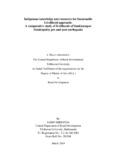Please use this identifier to cite or link to this item:
https://elibrary.tucl.edu.np/handle/123456789/2222| Title: | Indigenous Knowledge and Resources for Sustainable Livelihood Approach: A Comparative Study of Livelihoods of Sankharapur Municipality Pre and Post-Earthquake |
| Authors: | Shrestha, Sabin |
| Keywords: | Socio-cultural;Nature;Techniques |
| Issue Date: | 2019 |
| Publisher: | Central Department of Rural Development |
| Abstract: | The modern perspective regards indigenous construction practices as primitive, undeveloped and backward. They may be valid if they measure quality of life on the basis of luxury. But if they measure it on the basis of happiness, wellbeing and pride then traditional buildings can be an alternative. Use of indigenous materials and techniques is one of the main features of vernacular building. Indigenous knowledge has been founded on principles and understanding acquired from long tasting and experience by our ancestors to enhance sustainable development endeavours. The main objective of the study entitled “Indigenous knowledge and resources for sustainable livelihood approach: A comparative study of Sankharapur Municipality pre and post-earthquake.” is to assess the relation between IK and resources and sustainable livelihoods on the basis of five assets of capital prepared by DFID. Assessment of livelihood was based on field survey, observation, Interview and Focus Group Discussion where judgmental scoring method was applied. Structured and unstructured questionnaire tools were developed to collect data. It was developed on the basis of Sustainable Livelihood Framework Guidance Sheet. 40HH sample were chosen on random basis for questionnaire and interview was done to 8 local persons. Indigenous buildings are less vulnerable to earthquake. The technology of using wooden sill and lintel band around the buildings makes indigenous buildings safer during earthquake. Thermal behaviour of indigenous buildings are good which makes least use of thermal appliance to the user of the building resulting in the low operational cost. IK and resources also impact on socio-economic, environmental & cultural identity of building. Indigenous materials being entirely natural have no impacts on environment. The architecture of indigenous buildings are such that it offers maximum social interactions preserving its own cultural heritage. As for sustainable livelihood development, indigenous materials have potential to evolve and to be adapted to contemporary needs, helping to reduce embodied energy and environmental impacts and revive cultural heritage. Therefore, this paper addresses indigenous knowledge and resources as a sustainable livelihood approach in the context of Sankharapur and recommended to develop policies like subsidizing tax on using indigenous materials and techniques encouraging local people to adopts such knowledge. |
| URI: | http://elibrary.tucl.edu.np/handle/123456789/2222 |
| Appears in Collections: | Rural Development |
Files in This Item:
| File | Description | Size | Format | |
|---|---|---|---|---|
| thesis.pdf | 6.73 MB | Adobe PDF |  View/Open |
Items in DSpace are protected by copyright, with all rights reserved, unless otherwise indicated.
